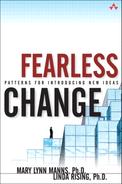Personal Touch
A manager was struggling with one of his staff. He had tried his standard approaches for bringing him on board and failed. He asked me how he should handle the problem. Should he fire the recalcitrant? After all, his usual techniques had not worked. I asked the manager to show me his key ring. I selected a key and queried, “What does this open?”
“The door to my car.”
“Will it also unlock your wife’s car?”
“No, of course not.”
“Well, it’s a perfectly good key. We know it works. Why don’t you just junk her car and get another one that will open with this key?”
People are different, so we can’t expect everyone to fit with the way we see things. Instead, find out what will unlock each person’s resistance to the new idea.[*]
To convince people of the value in a new idea, show how it can be personally useful and valuable to them.
You are an Evangelist(144) or Dedicated Champion(129) who is introducing a new idea into an organization.
Presentations and training will arouse curiosity and some interest in the new idea, but you must do more—the old habits of most individuals will not die without effort.
We tend to focus on the change we want to see in a team, a department, or an organization, when in reality, change happens one individual at a time. Changing a paradigm in an organization means convincing the individuals in the organization. People take change personally. They want to understand how the new idea can personally benefit them.
David Baum reminds us that your employees do not work for you, the department, the organization, the board of directors, or even the company’s clients. They work for themselves. This means that, in a time of organizational change, what matters most is the individual benefit each employee sees for his own life. It’s not that humans are inherently selfish, but rather that all change is essentially local.
One of the biggest mistakes change agents make is to just talk about the technical benefits. People need to first see a personal need for an innovation before they will listen to a discussion of the benefits. Successful change agents will determine what individuals need and ensure that the innovation addresses those needs.
Therefore:
Talk with individuals about the ways in which the new idea can be personally useful and valuable to them.
Take time to learn a person’s needs before you talk to him. Consider “eavesdropping” on problem discussions to discover how the innovation can solve an immediate problem. Ask questions and do a lot of listening. Practice “active listening” by acknowledging, restating, and summarizing ideas and discussion points.
Explain the ways in which the new idea will help with a work-related problem and how it is an improvement over what is already in place. You may want to concentrate on the ways it can help meet deadlines, because this is usually more convincing than showing how it may improve the quality of work. Keep in mind that your goal is not to change people, but rather to help them become more of who they already are.
Take advantage of the fact that people who learn about a promising innovation and see even small successes will seek additional information. When you see that someone is interested, find a comfortable, informal environment for discussion. Use Just Enough(180) to introduce them to the concepts.
Don’t wear yourself out by trying to talk with everyone. Recognize that you do not have the power or the personality to convince everyone. When someone doesn’t want to listen to you, try to find a Bridge-Builder(110).
= = = = = = = = =
This pattern builds a relationship with individuals, enabling them to discuss their personal needs that the innovation might address. People who hear about something that is personally useful are more likely to move past curiosity and become more interested and enthusiastic.
But some may see you as their personal guide to the innovation and will run to you with every problem. This can take time away from your primary responsibilities. Create an e-Forum(135) and use In Your Space(167) to communicate general solutions and uses for the innovation.
At one site in a global Fortune 500 company, the new technology group worked hard to become a part of each development team. They attended team meetings and listened for developers’ pain and tried to understand team dynamics. This helped formulate a strategy they could use when negotiating changes later. They looked for opportunities to add value and provide impromptu explanations of the new technology.
Budget cutting and layoffs often create an organization full of overworked, busy people. This is true in Jerry’s organization. So when he wanted to introduce a new idea, his colleagues responded with questions about the amount of work the idea would save them and create for them. Because everyone’s job is different, Jerry had to respond with different answers for each person.
